Flossing is an important part of oral hygiene, but it can be difficult to do with braces. So, you might wonder, what happens if you don’t floss with braces?
If you don’t floss with braces, you are more likely to develop cavities and gum disease. This is because food and plaque can get caught in between your teeth and around your braces, which can lead to decay and infection and also make your braces loosen. Therefore, it is important to make sure that you floss regularly, even if it is difficult to do so.
In this article, you’ll learn about the effects of not flossing with braces and ways to make flossing easier.
Should you floss while having braces?
You should definitely floss while you have braces! In fact, it’s more important to floss with braces than without them. This is because braces make it hard to clean teeth thoroughly, and brushing alone might not help.
Is not flossing with braces bad?
If you can maintain oral hygiene properly without flossing while wearing braces, then it’s not bad. But, it may make the work more difficult because you might end up with bad breath, tooth decay, gum disease, and other dental problems after the end of braces treatment.
Effects of not flossing with braces
Here are the consequences of not flossing with braces.
More plaque build-up
The brackets and wires of braces provide the perfect hiding place for plaques to form and collect.
If you don’t floss regularly, it will be more difficult to remove plaque. So, the plaque will continue to build up, leading to other dental problems.
Tartar build-up
If the plaque is not removed properly with flossing, over time the plaque will turn into tartar, which is much more difficult to remove.
Bad breath
If you don’t remove the food particles and bacteria from your teeth, they will start to decompose and cause bad breath.
Staining of teeth
When plaque and tartar are not removed, they can cause permanent staining of the teeth.
Loose braces
If you don’t floss with braces, the tartar and plaque can make the braces loosen since they will stick to the braces. As a result, the braces will not be able to work properly and might even fall off.
Pain and discomfort
You might experience pain and discomfort. This is because the plaque and tartar can irritate the gums and cause them to swell.
Swelling gum line
If you don’t floss and remove plaque and food debris properly, the gum line will start to swell due to inflammation of the gums. They will get hurt by your braces and eventually mess up orthodontic treatment.
Altered gum shape and position
If you don’t floss with braces, the tartar and plaque can cause the gums to become inflamed and bleed easily. Gum disease may potentially be the result of this.
Increased risk of gum disease
Plaque can also cause gum disease, gingivitis, or an infection of the gums. Gum disease can be a serious infection of the gums that can damage the bone around the teeth and lead to tooth loss.
An increased risk of tooth cavities
When plaque isn’t removed, it turns into tartar, which is a hard substance that can only be removed by a professional cleaning.
If tartar is not removed, it will continue to grow and eventually lead to tooth decay and cavities.
Potential for tooth loss
Periodontitis and gum disease will develop if plaque and tartar are not eliminated. This might lead to tooth loss.
Mouth sores
Mouth sores can also be a consequence of not flossing with braces. The food particles and bacteria can irritate the gums, leading to sores.
So, there you have it. These are the consequences of not flossing with braces. If you want to avoid these problems, be sure to floss regularly!
Why is flossing important with braces?
Flossing is important and, in many cases, mandatory with braces for various reasons.
When you have braces, it is more challenging for you to thoroughly remove all food debris and plaque because they create an irregular and rough surface all around your teeth.
So, you need to make an all-out effort to clean your teeth and braces thoroughly.
That’s why flossing is an important part of oral hygiene with braces to help remove food debris, plaque, and bacteria from teeth and gums.
It’s extremely necessary to floss around braces because food and other debris can easily become trapped in the brackets and wires.
If not removed, this can lead to decay, bad breath, and other oral health problems.
Flossing with braces can be a bit difficult and time-consuming, but it’s worth it to maintain good oral hygiene.
How often should you floss with braces?
The American Dental Association (ADA) recommends flossing at least once a day.
If you have braces, you may need to floss more frequently to ensure that your teeth and gums are clean.
Your orthodontist or dentist can give you specific instructions on how often to floss with braces.
In general, it’s a good idea to floss after every meal or at least twice a day while wearing braces.
Why is flossing so hard with braces?
Flossing with braces can be difficult because the wires can get in the way and make it hard to reach all of your teeth. In addition, the braces can make your gums more sensitive, so it is important to be careful when flossing.
How to floss with braces?
There are a few different ways that you can floss with braces. Let’s find out.
Waxed floss
Using waxed floss is one of the best ways to floss with braces because it is less likely to get stuck in the wires.
To use waxed floss, first, wrap the floss around your middle finger and then guide it under the wire to the gumline. Gently move the floss up and down against the tooth.
Floss threader
A floss threader is another great option for flossing teeth with braces on teeth. A floss threader is a tool that can be used to help thread the floss under the wire.
To floss with braces, you will need to use a floss threader. This is a tool that helps you thread the floss under the wires of your braces. You can find floss threaders at most pharmacies or online.
Orthodontic flosser
An orthodontic flosser is a tool that is specifically designed to floss teeth with braces. It has a small, angled head that helps you reach the wire and floss around the braces.
You can find orthodontic flossers online easily.
Interdental brush
Another effective way to floss your teeth with braces is by using an interdental brush.
An interdental brush is a small, ergonomically-designed brush that can reach between teeth and clean around braces, wires, and other orthodontic appliances.
To use an interdental brush, insert the brush between your teeth and then brush in a back-and-forth motion.
Regular floss or unwaxed floss
If you can’t find waxed floss, you can also use unwaxed floss. However, it is more likely to get stuck in the wires.
Regular floss is relatively inexpensive and easy to use.
To floss with regular floss, you’ll need to thread the floss under your wire and then wrap it around each tooth before flossing in a back-and-forth motion.
Dental floss picks
You can also use dental floss picks. Floss picks are easy to use and can be less messy than regular floss.
However, you might not be able to reach all the surfaces of your teeth with it because of braces.
To use a floss pick, simply insert the pick between your teeth and then floss in a back-and-forth motion.
Water flossers
Water flossers are also a great choice for flossing with braces.
They are easy to use and can be very effective in removing plaque and food debris from your teeth.
To use a water flosser, you’ll need to fill the reservoir with water and then direct the stream of water to your teeth.
You can also add mouthwash to the water for an extra fresh feeling.
Know how to use a water flosser with braces.
Also, check out the effects of not brushing teeth with braces.
Why can’t you floss with braces?
There are a few reasons why you can’t floss with braces.
First, the brackets and wires of braces can get in the way of flossing.
Second, it can be difficult to reach all of the nooks and crannies around your braces with floss.
Third, flossing with braces can be more painful than flossing without braces.
Finally, as flossing with braces can damage the wire or brackets, you might be afraid to use the floss.
For these reasons, it’s important to brush and use an inter
How can a patient with braces make flossing easier?
Use a special flossing tool or water flosser to make flossing easier, and be sure to visit your dentist regularly for professional cleanings.
A special flossing tool or water flosser to help you reach all of your teeth and remove plaque and debris.
You can also use an interdental brush or floss pick for flossing. However, you need to be careful not to hurt your teeth or damage the braces.
What is the best way to floss with braces?
The best way to floss with braces is by using a special orthodontic floss, waxed floss, floss threader, or an interdental brush. Another excellent option is using an electric water flosser, as it makes the work much easier and quicker.
Tips on flossing with braces
Here are some tips on flossing with braces.
1. If you floss too aggressively, you could damage your braces or injure your gums. So, be gentle and do it slowly.
2. Be sure to floss above and below the wire, as well as in between each tooth.
3. To make flossing faster and easier, consider a water flosser and/or a floss pick.
4. Visit your dentist regularly for professional cleanings.
5. Don’t forget to brush your teeth, too! This is because brushing teeth is the main component of oral hygiene.
Takeaways
Flossing with braces can be difficult, but it’s important to do it properly in order to avoid cavities and gum disease. Be sure to use the proper tools and techniques, and visit your dentist regularly for cleanings.
So, make sure to floss every day and Your oral health will thank you in the long run.


